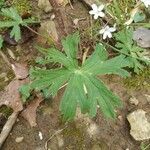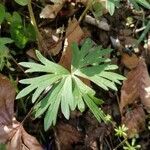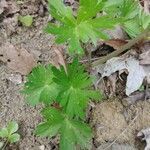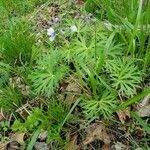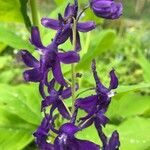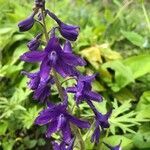Stems 20-60 cm; base often reddish, nearly glabrous. Leaves mostly on proximal 1/3 of stem; basal leaves 0-4 at anthesis; cauline leaves 2-8 at anthesis; petiole 4-12 cm. Leaf blade round, 2-8 × 4-12 cm, nearly glabrous; ultimate lobes 3-18, 5 or more extending more than 3/5 distance to petiole, width 2-10 mm (basal), 4-10 mm (cauline), widest at middle or in proximal 1/2. Inflorescences 5-15(-30)-flowered, less than 3 times longer than wide; pedicel 1-2.5 cm, puberulent; bracteoles 1-4(-6) mm from flowers, green, linear, 3-5 mm, puberulent. Flowers: sepals deep bluish purple to pink or white, puberulent, lateral sepals spreading, 11-19 × 4-7 mm, spurs straight, within 30° of horizontal, 13-16 mm; lower petal blades ± covering stamens, blue, except sometimes in white-flowered plants, 6-10 mm, clefts 0.5-2 mm; hairs sparse, mostly centered near junction of blade and claw, white. Fruits 14-22 mm, 4-4.5 times longer than wide, nearly glabrous. Seeds unwinged; surface of each seed coat cell with 1-5 small, swollen, elongate, blunt, hairlike structures, barely visible at 20× otherwise smooth. 2 n = 16.
More
Plants 2–6 dm, from a cluster of short, tuberous roots; lvs few, mostly at or near the base, deeply divided into several oblong-linear or cuneate segments; raceme 8–20 cm, softly short-villous, the pedicels 1–3 cm, the fls few, blue or sometimes white; spur 12–18 mm; lateral sep 11–15 mm, lower pet not bifid; follicles 10–15 mm, divergent; seeds smooth, triangular. Rich, moist woods; Pa. to s. Minn., s. to N.C., Ga., Ala., and Okla. Apr., May.
